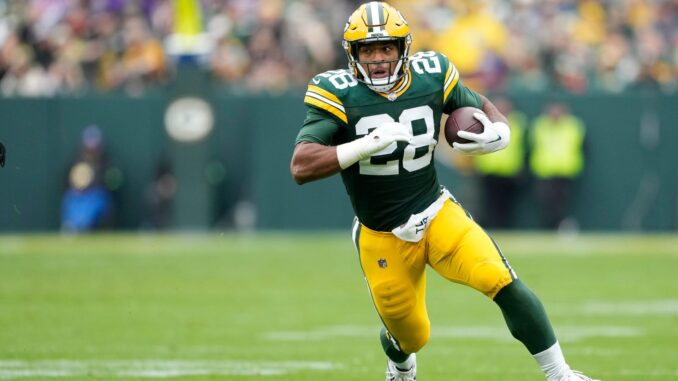
This offseason, the running back position is up for grabs for the Green Bay Packers. The deal with A.J. Dillon expires. Unrestricted free agency after four years in Green Bay, he can join with any team.
The Packers would want Aaron Jones, their main running back, to return, as stated by Brian Gutekunst.
The money would be the only roadblock in that. This is an excellent summary of the various ideas for how a Jones extension would affect the cap in 2024.
It makes sense for the Packers to explore elsewhere for Jones’ backup if he decides to play for Green Bay again the following season.
The market for running backs is currently unstable. Because running backs tend to break down earlier in their careers than athletes at other positions, teams are hesitant to give them hefty salaries. Dillon’s age-26 season is about to begin. A long-term contract from the Packers would be unwise given Dillon’s running style and mileage total.
At Boston College, Dillon carried the ball more than 845 times. On the other hand, D’Andre Swift and Clyde Edwards-Helaire, the two best backs in Dillon’s draft class, had a combined total of 810 carries in their three years before to being selected.
Dillon hasn’t been Green Bay’s main back, though. During his four years with the Packers, Dillon has carried the rock 597 times in total. The Packers employed Dillon as the main back when Jones was down, so it’s not an excessive amount of use.

Dillon’s PFF scores demonstrate his reliability. The Packers placed him in the right position. He can replace Jones in the offense with a different skill set because he is a large, bruising back. Before this year, Jones’ PFF grade was 75.7; in his second season, it was 86.7. Jones has never had a PFF grade below 75.7 or over 86.7.
Dillon has also seen a yearly trend in his metrics. Over the previous three years, Dillon has averaged 730 yards and four touchdowns. Every year, Green Bay is aware of about what they can expect from Dillon. But the criticism leveled against Dillon is his lack of adaptability. In the current NFL, running backs are required to catch passes out of the backfield. Even though it’s not his forte, Dillon can manage it. Given how diverse Green Bay’s offense is, the Packers might want a back behind Jones who is more adaptable.
The Packers are expected to exceed the salary cap by $6 million, according to Spotrac. The Packers will thus be trying to save money wherever they can. Even though it’s little, Dillon’s rise might be a result of Green Bay’s cost-cutting measures.
The rookie contract for Dillon expires this offseason. Dillon’s base pay was $1,321,458 for the previous season. This places him slightly ahead of former Minnesota Vikings running back Latavius Murray and behind rookie Tank Bigsby of the Jacksonville Jaguars. Dillon will, however, receive a significant raise.
According to Spotrac, Dillon is expected to sign a one-year contract worth $3.5 million, which is similar to that of Samaje Perine, Gus Edwards, and Ezekiel Elliott. As mid-20s change-of-pace backs who mostly play in the space between the tackles, all those players meet the description.
There are plenty of other choices in the draft, even though the Packers could certainly sign Dillon to a one-year, $3.5 million contract without breaking the bank. In the latter rounds, the Packers ought to be able to locate a valuable running back.
Green Bay will always be tempted to bring Dillon back because of his character as a teammate. He is aware of the offense and knows his position, so he probably won’t be too costly. However, Dillon is not as versatile as Jones or other draft choices, and the Packers need every penny they can get.
It would be prudent for the Packers to hold onto their money and let Dillon walk in free agency. This would enable them to select a more reasonably priced, more adaptable back in the draft who is clearly Jones’ apparent successor.
For more updates visit https://sportupdates.co.uk/

Leave a Reply